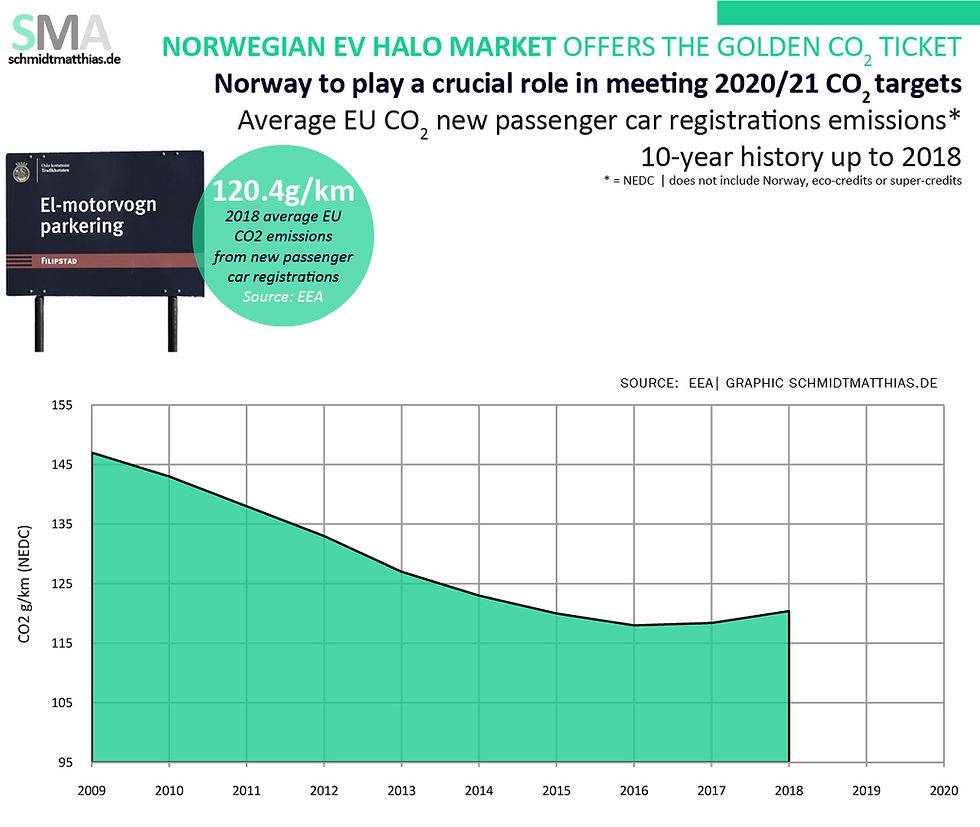Norway, the golden CO2 ticket
- Matthias Schmidt

- Aug 20, 2019
- 2 min read
Updated: Mar 3, 2020
Why EU 2020/21 CO2 targets are not as tough to achieve, as manufacturers might suggest
While many analysts and commentators are rushing to work out how much each passenger car manufacturer - doing business in EU Europe - will have to pay for missing latest new CO2 emissions targets, beginning in 2020, there is more to that simplistic analysis, with one key part of the equation missing... Norway.
Last year in the European Union, the average CO2 emissions from new passenger cars registered in the region reached 120.4g/km, rising for the second consecutive year, according to European Environment Agency (EEA) data. It therefore would appear an unrealistic and mammoth task for manufacturers to reach the magic fleet average target of 95g/km (at NEDC converted back from WLTP levels) of CO2 in 2020 (95% fleet of vehicles) and 2021 (entire fleet), one would assume.
However… this data doesn’t include, non-EU Norway.
2019 data will be the first monitoring year in which Norwegian data will be taken into account for the purpose of the assessment of CO2 emission performance in the region according to the European Commission. The Norwegian government ratified this agreement last year. Why is the addition of Norway significant?
Norway has the highest electric car penetration in the world. 44.3 percent of all the new cars sold in Norway up to July this year were pure electric vehicles, or more than every second vehicle (55.4%) if PHEVs are included, according to OFV data. The oil-drilling champion also recorded the highest volume of new pure electric passenger car registrations in Europe, with just under 40,000 hitting the road for the first time during the opening 7-months of the year according to OFV data. This is helped due to the fact that electric cars are omitted from a number of knee-trembling taxes aimed at traditional ICE vehicles. The omission of a number of these taxes on electric vehicles, allows the price of the vehicle to reach parity with same sector ICE vehicles while additionally receiving benefits such as no, or reduced, toll charges and lower parking fees. All of this correspondingly helped the Nordic market reduce its average CO2 emissions to just 67g/km in the opening 7-months of the year according to OFV data.
With Norway added to the EU equation since January 2019, we can expect 2019 CO2 data to fall dramatically. 2019 data will be published in February 2020.
The inclusion of Norway allows passenger car manufacturers an increasingly better chance of reaching their individual CO2 targets, based on the mass average fleet weight of all the vehicles it registers. Along with other golden tickets, joker cards and bonuses such as super-credits and eco innovation bonuses being handed to manufacturers - encouraging OEMs to bring likely loss-making electric cars to the market at an increasing pace - as well as electric car sharing fleet role-outs, the chances of achieving the "impossible CO2 targets", appear possible.
For further comments please contact




Comments